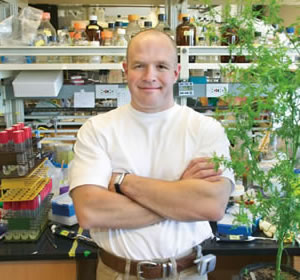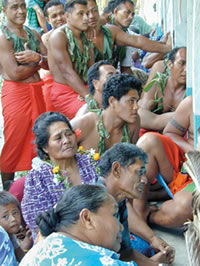
Living Systems and Quantitative Biology, page two

Jay Keasling's research on the rare Artemisia annua tree, pictured, led to the development of a less expensive, synthetic anti-malarial drug, to be produced and distributed thanks to a $42.6 million grant from the Bill and Melinda Gates Foundation.
“Synthetic biology” aims to design and construct novel organisms and biologically inspired systems that can solve problems natural biological systems cannot. Synthetic biological systems can also provide important new insights into how natural systems work. Berkeley Lab established the world’s first Synthetic Biology Department, and the research is already paying big dividends, with far greater rewards on the horizon.

Members of a Samoan village council listen to a presentation given in their language describing how genetic material from their mamala tree coupled with synthetic biology techniques could produce an anti-AIDS drug and bring them revenue without endangering their rain forest.
According to the World Health Organization, each year nearly 500 million people become infected with malaria, and nearly three million — mostly children — die from it. Jay Keasling, director of Berkeley Lab’s Physical Biosciences Division and a professor of chemical engineering at UC Berkeley, has led the development of a simple and much less expensive means of making one of the most promising and potent of all the new antimalarial drugs. By adding new genes and engineering a new metabolic pathway in E. coli bacteria, he and his colleagues can quickly and cheaply synthesize a precursor to the chemical compound artemisinin. This next-generation antimalarial drug has proven to be effective even against strains of the malaria parasite resistant to the current front-line drugs, but it is far too expensive right now for the countries in Africa and South America where it is needed most. The Bill and Melinda Gates Foundation recently awarded a $42.6 million grant to further the development of microbial artemisinin production. Meanwhile, Keasling and his colleagues have obtained similar results with prostratin, a rare chemical compound that holds enormous therapeutic potential as an anti-AIDS drug.
Despite continuing advances in diagnostics and treatment, cancer in all its many forms remains one of the leading causes of premature death. For women in this country, breast cancer is especially threatening, as it strikes one out of every seven. Berkeley Lab has a long history in breast cancer research. Scientists here discovered the critical link between tumor development and extracellular communications, uncovered vital new information on the damaging effects of ionizing radiation, identified new oncogenes and tumor-suppressing proteins, and developed new imaging techniques for tracking the spread of cancer. Most recently, a collaboration led by Joe Gray, director of Berkeley Lab’s Life Sciences Division, and including researchers with UC San Francisco and the National Cancer Institute, found a way to precisely identify the onset of the “telomere crisis,” an important early event in the development of breast cancer. Telomeres are the structures that protect the ends of chromosomes and prevent inappropriate cell growth that can lead to cancer. The work of Gray and his colleagues suggests that women at higher risk of developing breast cancer can be identified in advance by measuring telomerase activity. Early detection is the key to surviving any form of cancer.